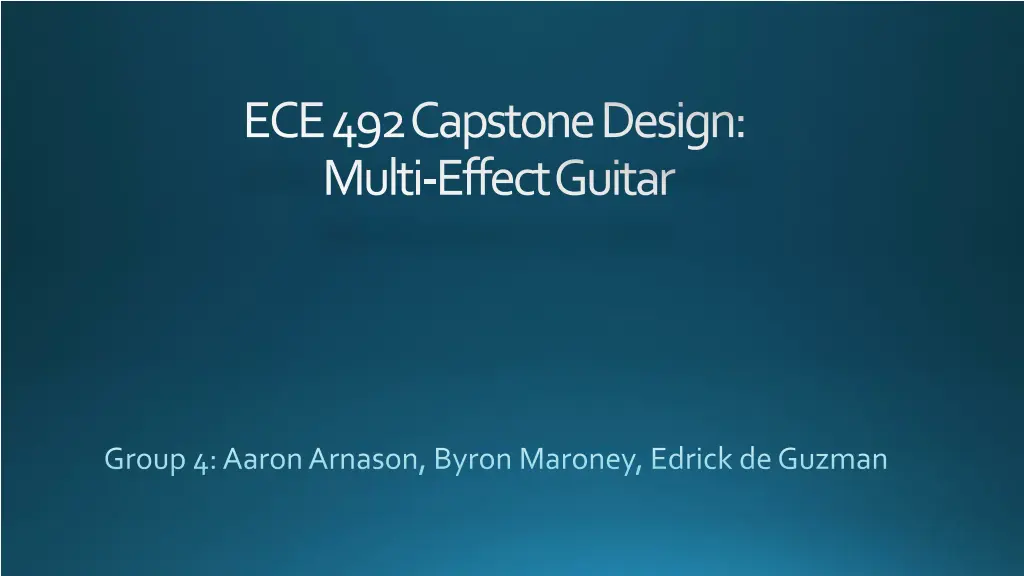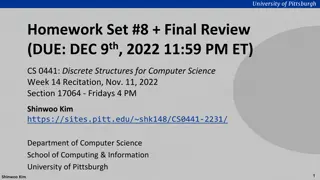
Exploring Audio Effects and Signal Processing in Guitar Design
"Discover the innovative project of Group 4 in ECE 492 Capstone Design, focusing on digital signal processing, distortion, delay effects, reverberation, and amplifier implementation for guitars. Learn about the challenges and solutions faced in creating unique audio effects."
Download Presentation

Please find below an Image/Link to download the presentation.
The content on the website is provided AS IS for your information and personal use only. It may not be sold, licensed, or shared on other websites without obtaining consent from the author. If you encounter any issues during the download, it is possible that the publisher has removed the file from their server.
You are allowed to download the files provided on this website for personal or commercial use, subject to the condition that they are used lawfully. All files are the property of their respective owners.
The content on the website is provided AS IS for your information and personal use only. It may not be sold, licensed, or shared on other websites without obtaining consent from the author.
E N D
Presentation Transcript
ECE 492 Capstone Design: Multi-Effect Guitar Group 4: Aaron Arnason, Byron Maroney, Edrickde Guzman
Motivation As guitarists, we wanted to explore how audio effects are applied Interesting to see what we could do with digital signal processing We wanted to explore the analog domain by building our own amplifier
Project Overview The project consists of the following: Digital Signal Processing Hard-clipping (Distortion) Delay Effect (Reverberation) Amplifier
Audio Properties The audio core handles 44.1 kHz sample rate. Since the DE2 s audio codec uses 16-bit sampling, the required bit-rate the DE2 audio codec s output is determined by: sampling frequency * bits per sample = bit rate This calculation results to 689.10 kbps (0.673 Mbps)
Distortion Effect Implementation Utilized hard clipping technique Clipping is a form of distortion Considered hard when clipping produces a flat-cutoff Flat-cutoffresults in a waveform closer to a squarewave Square waves introduce higher frequency harmonics Results in fuzzy or dirty audio effect
Distortion Effect Demo Challenges Clipping the amplitude introduces power loss Resulting in volume drop Resolved by amplifying the sample after the clipping process
Reverberation Effect Implementation The basic idea of reverb was first created using a variable delay with its signal fed back to create a series of delays that fade out over time Feedback gain must be less than 1
Reverberation Effect Demo Challenges Comb Filter as a side-effect Required a big enough space of memory (interfacing with off-chip memory) Frequency cancellations that can mimic room effects, but can also yield ringing and instability
Amplifier Implementation Using the LM384N as the amplifier IC The amplifier`s gain is internally fixed at 34 dB Which equates to voltage gain 50 times input signal Designed to boost signal coming from the DE2 Operational voltage between 12-26 volts DC. Potentiometer used for volume control Cost is around $4.00 w/o speakers.
Amplifier Demo Challenges Heating issue Clipping issue
Components List Altera DE2 Nios II Processor DSP Wolfson WM8731 Audio CODEC Amplifier LM384N IC Chip Visaton FRS 7 W 8 ohm speakers Electric Guitar
Optional Features Guitar Tuner Live Streaming Wireless Playability More Effects: Chorus Flanger Infinity Mirror (Visualizer) [1] - https://en.wikipedia.org/wiki/Infinity_mirror#/media/File:Ultraviole t_infinity_mirro.jpg
Questions http://vignette3.wikia.nocookie.net/spore/images/6/6c/Question-mark.png/revision/latest?cb=20110427230528




















